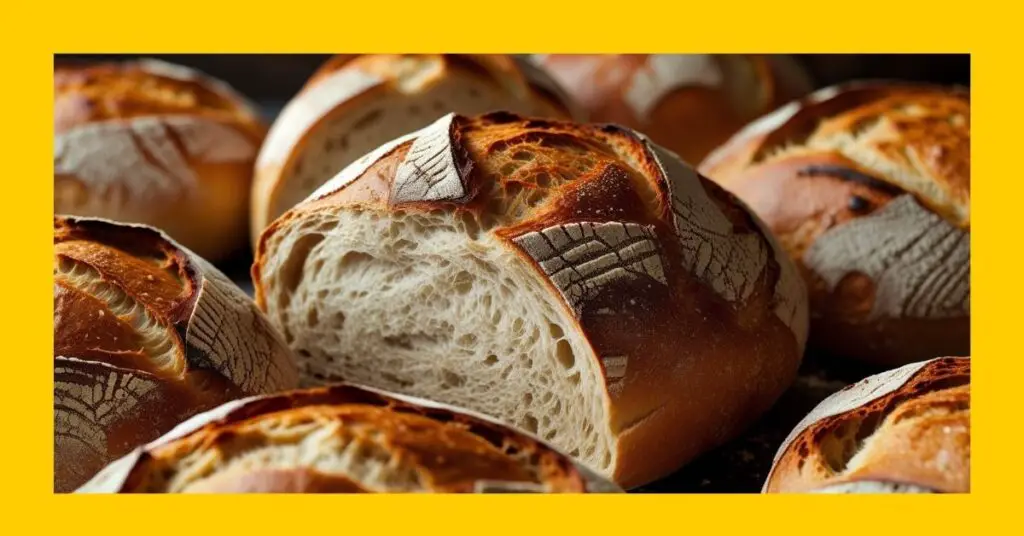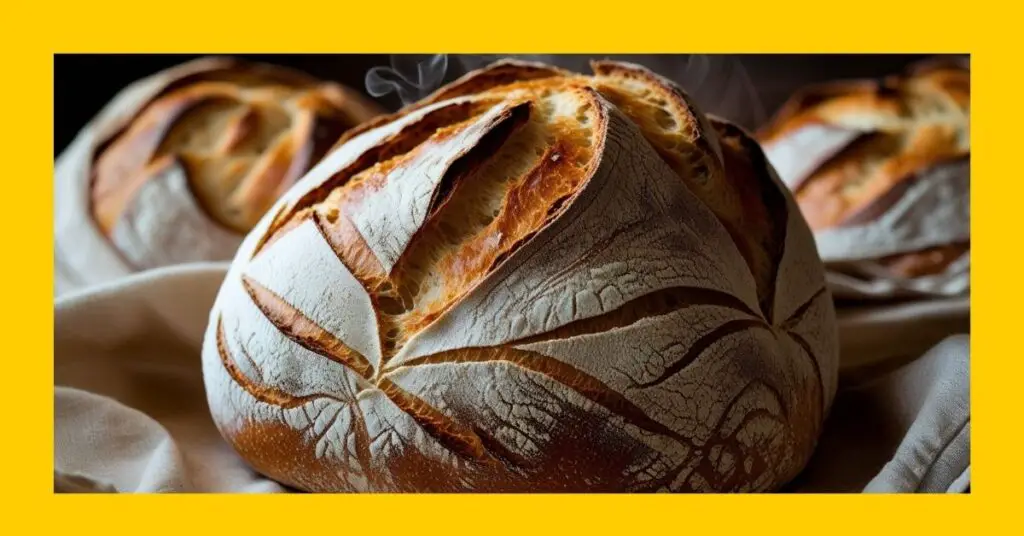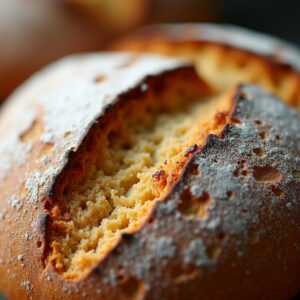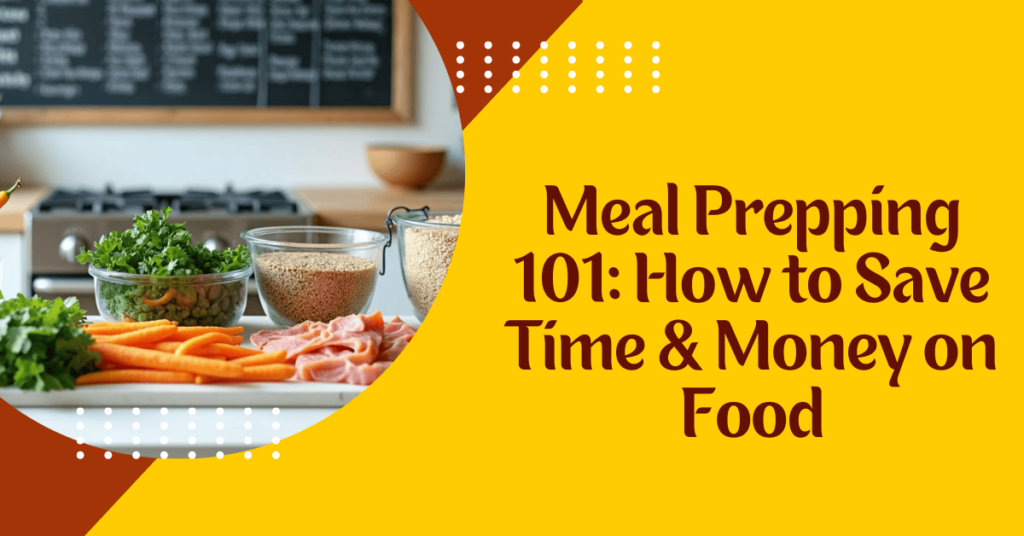Sourdough baking is a skill that has been handed down for generations. King Arthur sourdough recipe is remarkable because of its ideal balance of texture, flavor, and consistency. Whether you are an experienced baker or a beginner.
In this article, we will lead you through every step of the procedure, starting from creating a starter to baking a tasty loaf of Arthur Sourdough Recipe for bread.
What Makes King Arthur Sourdough Recipe Special?
Looking for the top sourdough bread recipe? King Arthur’s sourdough recipe is the most tried and true recipe out there. Combining top-of-the-line flour with a proven process means perfect results every time.
This recipe produces a perfectly crusty loaf with a light, airy interior. Sourdough, unlike commercial yeast bread, uses natural fermentation, so it has that wonderful tangy flavor.
All About the Science of Sourdough:
Sourdough breadmaking is a process of fermentation caused by wild yeast and lactic acid bacteria. This is how it goes:
- Wild Yeast Growth – Naturally occurring yeast in the starter helps the dough rise.
- Lactic Acid Production – Bacteria break down sugars, creating a tangy flavor.
- Gluten Development – Kneading and fermentation strengthen the dough structure.
This natural process results in a healthier, more flavorful bread compared to store-bought loaves.
Key Ingredients
Sourdough baking requires just four simple ingredients, but each plays a crucial role.
Essential Ingredients
| Ingredient | Purpose |
| King Arthur Unbleached Bread Flour | High protein for gluten development |
| Filtered Water | Prevents chlorine from killing wild yeast |
| Sourdough Starter | Provides natural yeast for fermentation |
| Salt | Enhances flavor and controls fermentation |
Using high-quality, unprocessed ingredients helps create the best possible sourdough bread.
How to Make a Sourdough Starter – Instructions:
A sourdough starter is a live culture of wild yeast and bacteria. It takes about a week to develop, but once ready, it lasts indefinitely with proper care.
Ingredients for a Sourdough Starter
- 1 cup King Arthur unbleached all-purpose flour
- ½ cup filtered water
Step-by-Step Process
- Day 1: Mix flour and water in a glass jar. Stir until smooth. Cover loosely.
- Day 2: Check for bubbles. Discard half of the starter and feed it with fresh flour and water.
- Days 3-5: Repeat feeding every 24 hours. The starter should begin to smell slightly tangy.
- Day 6-7: Your starter should be bubbly and active. It’s now ready to use in baking.
King Arthur Sourdough Recipe – A Complete Guide
Ingredients:
- 4 cups King Arthur bread flour
- 1 cup active sourdough starter
- 1½ cups water
- 2 tsp salt
Instructions:
- Mix the Dough: Combine flour, water, and starter. Stir until fully incorporated.
- Bulk Fermentation: Let the dough rest at room temperature for 4-6 hours. Stretch and fold the dough every hour.
- Shaping: Gently shape the dough into a round loaf.
- Final Proofing: Place the dough in a floured proofing basket and refrigerate overnight.
- Baking: Preheat the oven to 475°F. Bake in a Dutch oven for 20 minutes covered, then 15 minutes uncovered.
- Cooling: Allow the bread to cool completely before slicing.
Sourdough Discard Recipes – No Waste Baking:
Rather than throwing away unused sourdough starter, it can be reused in tasty baked treats. The fermented, tangy flavor lends richness to all sorts of recipes with less kitchen waste.
Sourdough discard makes recipes better through improved texture, flavor, and nutrition.
Pancakes – Light and Fluffy Breakfast Option!
Sourdough discard is a great mix-in for pancake batter. The fermentation adds natural flavor while the pancakes become tender and light. The tangy flavor complements syrup, fruits, or honey. Combine discard with flour, eggs, milk, baking soda, and a little sugar to create sourdough pancakes.
Crackers – Crunchy, Savory Snack
Homemade sourdough crackers are a simple means of converting discard to a crunchy snack. Fermentation in the starter gives a distinct depth of flavor, so these crackers are considerably more flavorful than those from a store. Combining discard with flour, butter, salt, and herbs produces an easy dough that can be rolled thin and baked golden brown.
Muffins – Adds Moisture and Depth of Flavor!
Combining sourdough discard with muffins produces a moist and richly flavored bread with a delicate crumb. The natural acid breaks down the flour, and the muffins become tender, with a mild tang added to them. It works particularly well in banana, blueberry, or chocolate muffins.
Pizza Dough – Improves Chewiness and Flavor!
Adding sourdough discard to pizza dough produces a deep, rich flavor with a chewy texture. The fermentation process also makes the gluten stronger, so the dough is more stretchy and easier to shape. By substituting some of the flour and water with discard, the dough has a subtle tang that pairs beautifully with pizza toppings.
Try This: Easy Oatmeal Cookie Recipe – Soft, Chewy, and Foolproof!
Overnight Sourdough Recipe – The Best Way to Enhance Flavor:
The overnight fermentation method deepens the sourdough flavor and improves texture.
1. Mixing the Dough (Evening Preparation):
- In a large bowl, combine the flour and water. Mix until all the flour is hydrated. Let it rest for 30 minutes (autolyse process).
- Add the active sourdough starter and salt to the dough. Mix well.
- Knead the dough gently for about 5-7 minutes until it becomes smooth and elastic.
2. Bulk Fermentation (Room Temperature):
- Cover the bowl with a damp towel and let the dough ferment at room temperature for 4-6 hours.
- Perform stretch and folds every 30-60 minutes to strengthen the gluten.
3. Cold Proofing (Overnight in the Refrigerator):
- Lightly flour a proofing basket or bowl. Shape the dough into a round or oval loaf.
- Place the dough in the basket, seam-side up. Cover with a plastic wrap or towel.
- Refrigerate for 12-18 hours to allow slow fermentation.
4. Preheating and Baking (Morning Baking):
- Preheat the oven to 475°F (245°C) for at least 30 minutes before baking.
- Place a Dutch oven inside while preheating to ensure even heat distribution.
- Remove the dough from the refrigerator and place it on parchment paper.
- Score the top with a sharp knife or razor blade to allow controlled expansion.
- Transfer the dough into the preheated Dutch oven. Cover with the lid.
5. Baking Process:
- First 20 Minutes: Bake with the lid on to trap steam, which helps the crust develop.
- Last 15 Minutes: Remove the lid and continue baking until the crust turns deep golden brown.
- The bread is done when it sounds hollow when tapped on the bottom.
6. Cooling the Bread:
- Let the bread cool on a wire rack for at least 1 hour before slicing.
- Cutting too early can cause the interior to become gummy.
Sourdough Sandwich Bread – Soft and Fluffy:
For those who prefer a softer, less chewy texture, this sourdough sandwich loaf is ideal.
Ingredients:
- 3½ cups King Arthur all-purpose flour
- 1 cup sourdough starter
- 1¼ cups milk
- 1 tbsp honey
- 2 tsp salt
- 2 tbsp butter
Steps:
- Mix all ingredients. Knead until smooth.
- Let it rise for 6 hours.
- Shape into a loaf and place in a greased pan.
- Proof for 2 more hours.
- Bake at 375°F for 35 minutes.
How to Preserve Sourdough Discard for Future Use?
Correctly storing sourdough discard keeps it fresh and ready to use for subsequent recipes. It can be stored in some different ways, depending on when you intend to use it.
Refrigeration – Short-Term Storage:
For regular use in the space of a week, the best thing to do is store it in the refrigerator. Keep it in an airtight container to make sure it does not dry out or pick up other odors.
Freezing – Long-Term Storage
For long-term preservation, freezing works very well. Sourdough discard can be stored in the freezer for as long as three months without degrading its baking function. For ease of thawing, divide the discard into small portions and then freeze it. Ice cube trays or flexible molds are great options for this.
Dehydration – Extended Shelf Life
Dehydrating sourdough discard makes it possible to store it indefinitely. Spread a thin layer of discard on parchment paper and allow it to air dry or use a dehydrator at low temperature. Once dry, crumble it into pieces and store it in an airtight container.
Try This: Birria Tacos Recipe Authentic – A Flavorful Mexican Delight!
How to Serve Sourdough Discard Recipes?
Sourdough discard recipes provide a range of serving options, whether for breakfast, snacks, or dinner. The tangy taste complements both sweet and savory foods, making it a great ingredient for any meal of the day.
Breakfast Ideas:
- Pancakes & Waffles – Serve with fresh fruits, maple syrup, or a dollop of yogurt for a balanced meal.
- Muffins – Perfect grab-and-go breakfast option, pairs well with coffee or tea.
- Sourdough Crepes – Thin and soft, great with sweet or savory fillings.
Snacks and Appetizers:
- Crackers are ideal for cheese platters or charcuterie boards. They pair well with creamy cheeses, hummus, or fruit spreads.
- Soft Pretzels – Best enjoyed with mustard or a cheese dip.
- Sourdough Breadsticks – Crispy and flavorful, great with marinara or garlic butter.
Main Course Pairings:
- Pizza Dough – A flavorful base for homemade pizzas, topped with fresh tomato sauce, mozzarella cheese, and favorite toppings.
- Savory Biscuits & Rolls – A perfect side dish for soups, stews, and roasts.
- Flatbreads & Tortillas – Great for wraps, sandwiches, or dipping into hummus.
Dessert Options:
- Cakes & Cupcakes – The slight tang enhances the sweetness, creating a balanced flavor.
- Cookies – Adds a soft and chewy texture with a slight sourdough depth.
- Cinnamon Rolls – The fermented starter adds a rich, complex flavor to the dough.
FAQs
How long does sourdough starter last?
A sourdough starter will last indefinitely if it is well-fed and cared for. Store it at room temperature with a daily feeding or in the fridge and feed it once a week.
Can I bake sourdough bread without a Dutch oven?
Yes, you can bake it on a preheated baking stone or baking sheet. To produce steam, put a tray of hot water in the oven, which aids in creating a crispy crust.
Why is my sourdough bread too dense?
A dense loaf usually indicates the dough was under-proofed or did not develop adequate gluten. Let it rise completely and stretch and fold it during fermentation.
How do I make my sourdough less sour?
To minimize sourness, decrease the fermentation time, employ a newly fed starter, or add a small amount of honey or milk to counteract the flavor.
Can I substitute all-purpose flour for bread flour?
Yes, but the bread will be less chewy because all-purpose flour contains less protein. For improved structure, blend it with bread flour or knead it longer to develop gluten.
Conclusion
Creating King Arthur sourdough bread at home is a rewarding process. With some basic ingredients and the correct procedures, you can bake a crusty, full-flavored loaf to satisfaction every time. This guide assists in getting the optimal results whether you want traditional sourdough, overnight ferment, or soft sandwich bread.
King Arthur Sourdough Recipe
Ingredients
- 1 cup 227g ripe (fed) sourdough starter
- 1 ½ cups 340g lukewarm water
- 1 to 2 teaspoons instant yeast optional, for quicker rise
- 2 ½ teaspoons 15g table salt
- 5 cups 600g King Arthur Unbleached All-Purpose Flour
Instructions
- Mix the Dough: Combine sourdough starter, lukewarm water, yeast (if using), and salt. Add flour and mix until a rough dough forms.
- Knead the Dough: Transfer to a floured surface and knead for 7-10 minutes until smooth and elastic.
- First Rise: Place in a greased bowl, cover, and let rise until doubled (1-2 hours).
- Shape the Loaf: Gently deflate, shape into a round or oval, and place on parchment or in a Dutch oven.
- Second Rise: Cover and let rise until puffy (about 1 hour).
- Bake the Bread: Preheat oven to 450°F (232°C). Score the loaf, bake for 20 minutes covered, then 20-25 minutes uncovered until golden brown.
- Cool and Serve: Let cool on a wire rack before slicing.
Notes
- Starter Maintenance: Ensure your sourdough starter is active and bubbly before using for the best rise.
- No Yeast Option: The recipe works without yeast, but the rising time may be longer (4-6 hours total).
- Crust Variation: For a crispier crust, bake with steam by placing a pan of hot water in the oven.
- Storage Tips: Store in an airtight container at room temperature for up to 3 days or freeze for longer freshness.
- Flour Substitutions: You can mix whole wheat and all-purpose flour, but it may affect the texture.
- Bread Texture: For a softer crust, brush with butter after baking.






